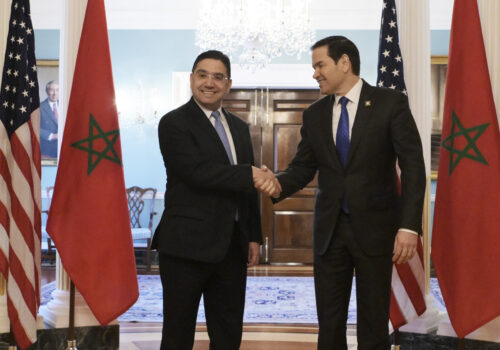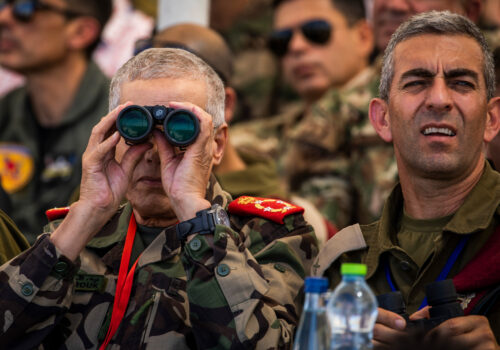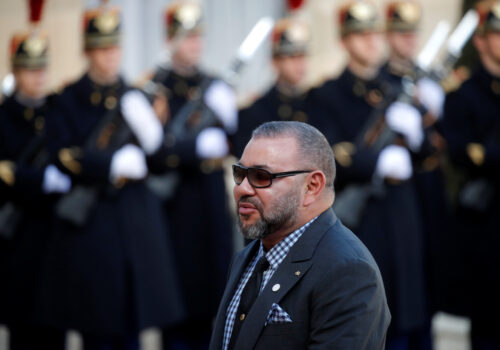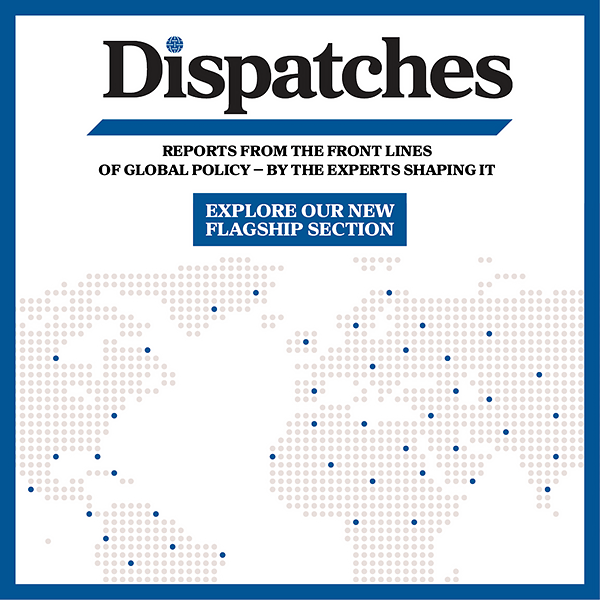Four questions (and expert answers) about the antigovernment protests in Morocco
Youth-led protests continue to escalate in multiple cities across Morocco, with three people killed in an altercation with security forces, Moroccan authorities announced Thursday. Below, Sarah Zaaimi, a resident senior fellow for North Africa at the Atlantic Council’s Rafik Hariri Center and Middle East programs, answers four pressing questions about the ongoing demonstrations.
1. Who is protesting?
Moroccan youth took to the streets starting September 27, after calling for general protests across the kingdom on social media using the #GenZ212 hashtag to mobilize and demand more accountability and improved public services. (The number 212 refers to Morocco’s telephone country code.) Those leading the demonstrations were initially mostly Gen Z individuals, who were apparently inspired by the momentum created by this generation in other parts of the world such as Nepal, Indonesia, and Madagascar. These demonstrations are the largest in the country since the Arab Spring and the February 20 movement, which led in 2011 to constitutional reforms limiting the power of the monarchy and providing more authority to the executive and legislative branches.
This new type of protest is unique because it is largely organized by a digital generation using the tools and ideals of Gen Z—coordinating and arranging an entire social movement on platforms such as Discord, Twitch, and TikTok. Unlike in other demonstrations in Morocco, where civil society, opinion leaders, and political parties take the lead—as seen over the past two years in the pro-Palestine protests—this wave extends beyond the country’s traditional political and business elites, civil society leaders, and media.
For the past three days, the demonstrations have taken a more violent turn in some of the most impoverished towns and suburbs, where socioeconomic disparities are more pronounced and the populations are increasingly frustrated with the political class. This includes cities such as Sale, Inezgane, and Oujda. Some demonstrations that had been peaceful have been hijacked by new groups, mainly minors from Gen Alpha, who have vandalized and looted public and private property, according to the Interior Ministry’s spokesperson, Rachid El Khalfi.
Last night, the authorities responded with live ammunition when a group of minors stormed a gendarmerie barricade in Lqliaa, Southern Morocco, resulting in the death of three people. The Moroccan Ministry of Interior also announced the injury of 354 people, mostly from law enforcement, and damage to private cars, shops, banks, and public buildings across twenty-three regions.
2. Why are they protesting?
The demonstrations started after Morocco unveiled its new Moulay Abdellah soccer stadium in Rabat in mid-September. The stadium reportedly costs $75 million and it is scheduled to host the African Cup this December. Simultaneously, reports of several patients dying of medical negligence in Agadir brought back to the surface questions about the country’s development priorities. Frustration over degraded health and education services, while the government is actively gearing up to erect state-of-the-art sports infrastructure to meet its 2030 World Cup hosting targets, is compounding the crisis.
In a recent speech, King Mohamed VI described Morocco as a two-speed economy, where opposites coexist in the same dysfunctional context. On one hand, ambitious infrastructure and industrial projects are underway, while on the other, basic vital public services are performing poorly.
Youth, who make up nearly a third of the population, say they feel disenfranchised by the country’s policies and international ambitions, which mainly target external audiences and tourists. Entire neighborhoods are being reduced to rubble to make space for new hotels, highways, and stadiums. At the same time, progress in the vital fields of education, youth employment, and medical services remains unsatisfactory. Adding to the problem, Morocco has not yet fully recovered from the economic crisis and inflation caused by the COVID-19 pandemic, and it has still not fully compensated victims of the 2023 Al Haouz earthquake.
Demonstrators have also leveld accusations of corruption against the current coalition government, which has been in power since October 2021 and is led by Prime Minister Aziz Akhannouch. Akhannouch, one of Morocco’s wealthiest businessmen and the head of Akwa Group, with a reported net worth of $1.6 billion, has been under scrutiny for potential conflicts of interest between his personal business dealings and state projects. Some voices within the new protest movement are also calling for the government to step down and be held accountable for any mismanagement of public funds.
3. How has the Moroccan government responded?
In the first few days of the demonstrations, the authorities apprehended around one thousand protesters, according to the Moroccan Association of Human Rights, for holding unauthorized protests. Many of these protesters have since been released. But as frustration grew over the government’s lack of communication and limited response, more violent confrontations between the authorities and a mixture of mobsters and demonstrators started dominating parts of the movement, especially in the suburbs and more underdeveloped towns, resulting in casualties and chaos.
Akhannouch addressed the protests in public remarks on Thursday, six days after the start of the protests. He expressed his sadness amid the unfortunate escalation of violence. He vowed the readiness of his cabinet to respond to the demands voiced by Morocco’s youth and to engage in dialogue within institutions and public spaces.
Given the complex nature of the constitutional monarchy in Morocco, dividing powers between the monarch, “the commander of the faithful,” and the elected executive and legislative branches, many demonstrators also look up to King Mohamed VI to take firm decisions and enact drastic systemic reforms to adress the failure of the political class and degrading services. The king had previously responded positively to the Arab Spring’s demonstrations in 2011, allowing Moroccan society to experience what commentators have referred to as “an evolution rather than a revolution,” unlike other Arab countries in the region. However, the 2011 constitutional reforms would make it difficult for the king to simply dissolve the government, and it would require a broader consensus and action from the parliament’s side. Moroccan youth are also looking for signals from Crown Prince Moulay Hassan, a member of Gen Z himself, who has been playing a greater role in the political and development sphere as part of the long-term succession process.
4. What should we expect next?
With general elections scheduled to take place in September 2026, the current Gen Z uprising will undoubtedly reshape the political conversation in Morocco and help recenter the government’s priorities beyond the spectacle- and infrastructure-focused policies ahead of the 2030 World Cup. Given the country’s track record in managing crises, Morocco will likely absorb the current events and gradually return to normalcy. While it is unlikely that this new social movement will evolve into a more transformative revolution, as was the case in Nepal, it is still a pivotal moment for the country and a wake-up call. It is clear that there is a deep rift between a digitally connected and politically critical generation and the current governing elites, and whose priorities focus on stones rather than humans.
It is also essential to watch for any ripple effect of these demonstrations in the larger Middle East and North Africa region, like what happened during the Arab Spring, when the wave of protests started in Tunisia and then spread across other Arab countries. Neighboring Algeria is already bracing for similar protests under the label of #GenZ213 (using Algeria’s telephone code of +213) on Friday.
Sarah Zaaimi is a resident senior fellow for North Africa at the Atlantic Council’s Middle East programs, focusing on identity and minorities in the region. She is also the center’s deputy director for media and communications.
Further reading
Tue, May 6, 2025
A blueprint for a trilateral Morocco-Israel-US investment fund
MENASource By
Amid instability in the Mediterranean, North Africa and the Sahel, a chance to deliver on the promise of the Abraham Accords.
Tue, Jan 21, 2025
How the Gaza war brought Morocco and Israel closer
MENASource By Sarah Zaaimi
Security cooperation between Israel and Morocco is flourishing and has never been stronger, driven by a common Iranian threat and a shared vision for regional integration.
Mon, Nov 25, 2024
Why Morocco could see its importance to Washington rise during Trump 2.0
New Atlanticist By Rama Yade
For strategic and economic reasons, Morocco is likely to play a central role in the new Trump administration’s policy toward the Middle East and the Sahel.
Image: Protesters demonstrate in downtown Casablanca during youth-led demonstrations demanding better education and healthcare, in Casablanca, Morocco, October 2, 2025. REUTERS/Stringer



